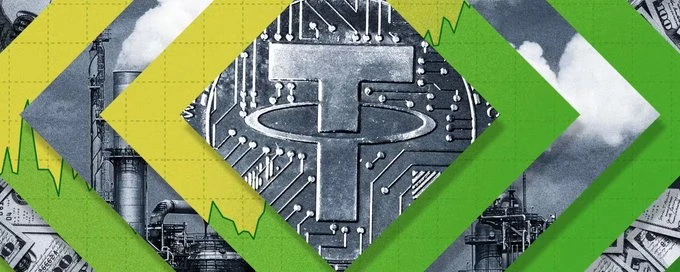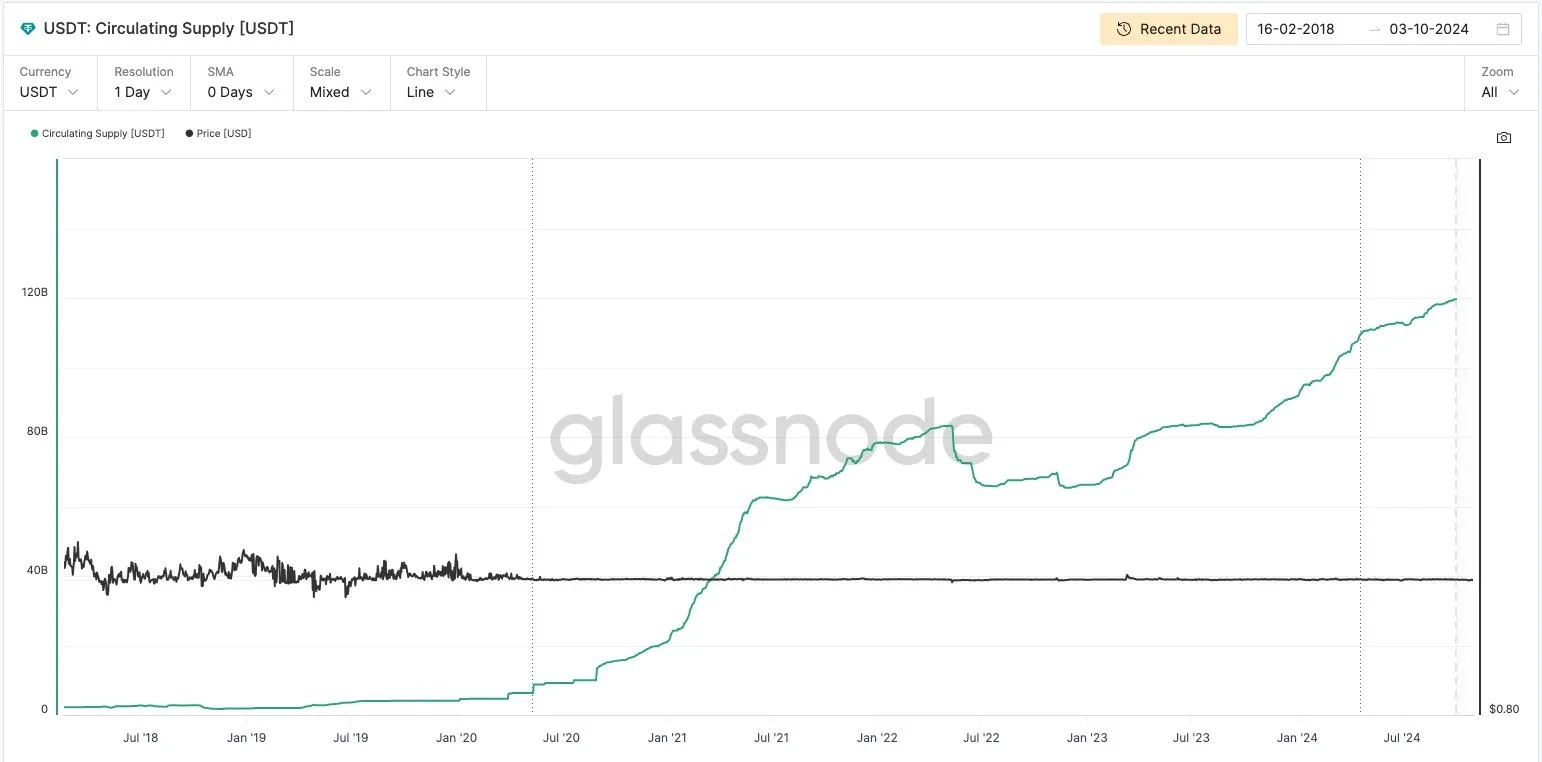Original author: YettaS (X: @YettaSing )
Introduction: Money is the sexiest business, but it is always accompanied by the game between new and old powers.
How to find the breakthrough point (utility) of the scene, how to deepen its liquidity (liquidity), and how to make the two enter a positive flywheel, all of this requires finding ones own development path after understanding the power structure.
Every step is like walking on thin ice, the winner is the king and the loser is the bandit.

USDT has become the most important liquidity tool in the offshore market with its wide circulation and huge asset size around the world, but we have never stopped asking questions about Tether: Why is Tether the de facto central bank of our industry? Why is the attitude of US regulators so conflicting - neither completely suppressing it nor giving clear support? What does its existence mean to the US financial market? In this tug of war, where is its breakthrough point? This article will help you think about the significance of stablecoins from a more macro perspective, which is the premise for breakthroughs in this field.
What kind of good business is Tether?
Tethers latest Q3 data shows its strong profitability. As of Q3, its total assets reached $125bn , of which US bonds were about $102bn , Q3 net profit was $2bn , and the annual cumulative profit was $7.7bn . In comparison, BlackRocks Q3 profit was $1.6bn , Visas was $4.9bn , and Tethers staff was less than one percent of theirs, but its labor efficiency was more than 100 times theirs.

source: primitive ventures
In fact, Tether did not have a very explosive start. It started from a small demand. At that time, all exchanges were trading BTC pairs, and the prices on both sides were floating, which made settlement very inconvenient. Bitfinex discovered this problem and launched USDT as the unit of account (UoA). This was the first scenario it found. In 2019, Sun Ge discovered the demand for stablecoins across exchanges. ETH to U was expensive and slow, while Tron was cheap and fast. Sun Ge immediately began to subsidize the market on a large scale , spending hundreds of millions of yuan (of course from Tron node income) to subsidize TRC 20-USDT exchange deposits and withdrawals. At that time, deposits and withdrawals could basically enjoy 16%-30% of income. As a medium of exchange (MoE) for transfers between exchanges, this was the second scenario it found. Everyone knows the subsequent story. USDT was widely adopted by the off-chain world, as a store of value (SoV) in countries with hyperinflation, as a medium of exchange (MoE) in various gray areas, and becoming a shadow dollar was its third scenario. After three evolutions, Tether has grown along with the market value and liquidity of USDT.
Regarding how to make a stablecoin, Dovey’s article has very detailed instructions, you are welcome to learn.

source: Glassnode
Currently, more than 80% of Tethers assets are invested in US bonds, which makes Tether almost have the characteristics of a US government money market fund, that is, high asset security and sufficient liquidity. As a SoV, it is safer than deposits. Deposits have bank asset risks. The impact of SVBs bankruptcy on USDC is an example, while government bonds are the lowest-risk financial product.
At the same time, it is also better than money funds, because money funds do not have the function of currency settlement, they are just products for sale and cannot become currency circulation itself. This is also the reason why Tether can be so efficient. USDT as MoE is far superior to existing cross-border settlement or payment channels in reducing the friction of currency circulation. As the nominal shadow dollar and the UoA with the strongest consensus, various channels and exchange platforms have become Tether workers to help it spread its network to the world.
This is the charm of the currency business. Tether combines payment, settlement, and treasure management to become the de facto Federal Reserve of our industry, which was unimaginable before crypto. Its network effect expands as liquidity expands. This cannot be subverted by distributing 5% of the yield to users and using token vampire attacks.
At this point, we can understand why Paypal wants to issue stablecoins, because as its business expands, it has achieved fund precipitation and payment settlement, and stablecoins are the best carrier for all of this. From another perspective, wouldn’t American banks and monetary funds be jealous of this business?
From Big and Unbreakable to Deep and Unbreakable
It is actually very simple for the United States to get rid of Tether, because the custody of U.S. debt is very centralized, and Tether has been investigated by the Department of Justice since 2021, and was transferred to Darmian William, the popular fried chicken prosecutor in the Souther District of NY, at the end of 2022 (basically all high-level crypto crime cases are in his hands, including the SBF case). So it’s not that they can’t, but that they don’t want to. So what is the reason for not wanting to?
First, there is the liquidity risk of the U.S. Treasury market. 80% of Tether’s assets are U.S. Treasury bonds. If regulators take extreme restrictive measures against it, causing Tether to sell off U.S. Treasury bonds on a large scale, this could trigger turmoil or even a collapse in the U.S. Treasury market. This is too big to fail.
More importantly, USDT is expanding globally as a shadow dollar. In areas of severe inflation, USDT is seen as a means of storing value; in areas of financial sanctions and capital controls, USDT becomes a circulating currency for underground transactions; it can be seen in terrorist organizations, drugs, fraud, and money laundering. When USDT is used in more countries, more channels, and more scenarios, its anti-fragility will be greatly enhanced. This is deep but not falling.
The Federal Reserve must be pleased to see this. On the surface, the Federal Reserve has the dual mission of maintaining price stability and achieving full employment, but at a deeper level, it is to strengthen the hegemony of the US dollar and control global capital flows. It is the widespread circulation of USDT and USDC that has helped the US dollar expand offshore liquidity. USDC is a regulated US dollar on/offramp tool, while USDT has penetrated the US dollar into the world through its extensive channels. USDTs underground banking system and gray remittance services are actually facilitating the circulation of US dollars and cross-border payments. This helps the United States continue to play a leading role in the global financial order, and the hegemony of the US dollar has been further deepened.
Where does Tether’s resistance come from?
Although Tether has helped the United States continue its financial hegemony in many ways, its game with U.S. regulators still exists. Hayes once said that Tether can be shut down by the U.S. banking system overnight, even if it does everything by the book.
First, it cannot support the Fed’s monetary policy. As a fully-reserve stablecoin, Tether will not adjust liquidity with the Fed’s monetary policy, and cannot participate in the Fed’s quantitative easing or monetary tightening like commercial banks. Although this independence enhances its credit, it also makes it difficult for the Fed to achieve its monetary policy goals through it.
Secondly, the Ministry of Finance should be wary of it causing turmoil in the U.S. bond market. If Tether collapses due to an unexpected event, it will have to sell a large amount of U.S. bonds, which will bring huge pressure to the U.S. bond market. This was widely discussed at the Treasury Borrowing Advisory Committee on October 29. Is it possible to directly tokenize U.S. bonds through some methods to reduce the impact of USDT on the U.S. bond market?
Last but not least, Tether is actually squeezing the living space of banks and money funds. The high liquidity and high returns of stablecoins have attracted more and more users, and the deposit absorption capacity of banks and the attractiveness of money funds have been greatly challenged. At the same time, Tethers business is too profitable, so why cant banks and money funds do it? The Lummis-Gillibrand Payment Stablecoin Act was proposed in April this year , which encourages more banks and trust institutions to participate in the stablecoin market, which is a strong proof.
The development of Tether is actually a magnificent history of struggle. The regulatory arbitrage that carries the original sin has given it huge development opportunities and space. Now there are finally some forces that can begin to compete with the old forces. No one can say where it can go, but any groundbreaking innovation is a redistribution of the past power and interest structure.
The possibility of a supranational currency system
To surpass the US dollar system, the future of Tether is not only to maintain the global payment and liquidity role, but also to think more deeply about how to build a truly super-sovereign currency system. I think the key lies in the peg with BTC. In 2023, Tether took the lead in taking this step and allocated 15% of its profits to Bitcoin. This is not only an attempt to diversify its asset reserves, but also a fact that makes BTC an important part of supporting its stablecoin ecosystem.
In the future, as Tethers payment network expands and BTC deepens as a supranational currency in the global market, we may witness a new financial order.
A revolution often starts from the margins, sprouting in the cracks of decaying beliefs in the old times. The worship of Rome made the dominance of Roman civilization into a self-fulfilling prophecy.
The birth of new gods may be random, but the twilight of old gods is inevitable.










